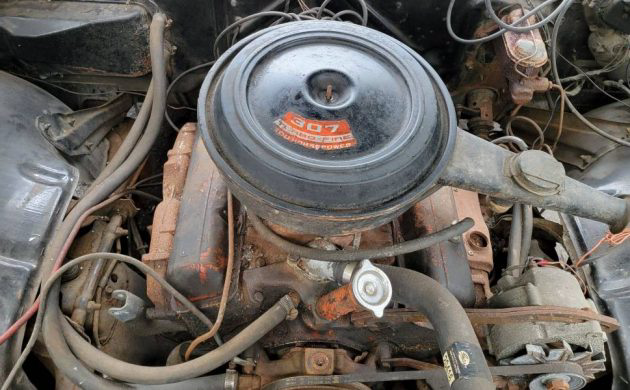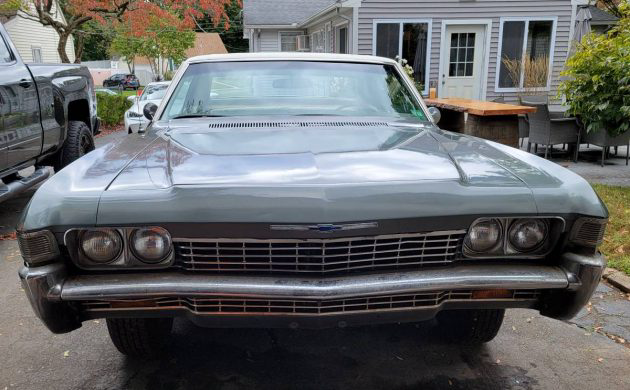Original As It Gets: 1968 Chevrolet Impala Custom
Well, well, what do we have here? It’s essentially a 1968 Toyota Camry/Honda Accord. Not really, of course, it’s one of 711K Chevrolet Impalas sold that year but it was the Camry/Accord of its day. And this example appears to be original and best of all, not messed with; let’s check it out! This Impala Custom is located in New Haven, Connecticut and is available, here on craigslist for $8,350. Thanks to Pat L. for this tip!
The Impala Custom was introduced in ’68 and it’s essentially a downgraded version of the Caprice coupe as it employed the same formal roofline. Also available was the Impala “Sports Coupe” which had the more recognizable slope-back, or fastback roofline that first appeared in ’65. The third leg of the Impala two-door trio was the convertible which was good for about 24K copies. Four-door models came in three different body styles, a sedan, hardtop, and station wagon. Throw in the Caprice, Bel Air, and Biscayne and Chevy’s full-size B-body count totaled about 1.2M for ’68 – it was a good year indeed.
Another new item for ’68 was the 200 gross HP 307 CI V8 engine, replacing the venerable 283 which saw use for eleven model years. Connected to the all too familiar Powerglide, two-speed automatic transmission, this 100K recorded mile powertrain combination is a non-runner. Of note, is the “engine retention bracket” located on the front passenger side of the engine (left side of image) and attached to the exhaust manifold. In December 1971, the National Highway Traffic Safety Administration (NHSTA) ordered that Chevrolet recall millions of V8-equipped cars produced between 1965 and 1969 because of faulty and separating engine mounts. Chevy dragged their feet for some time on offering a solution and came up with this half-behind way of repairing the problem. Instead of replacing the tearaway mounts, they designed a pair of steel brackets that attached to the exhaust manifold bolts, on both sides of the engine, and then used a short steel cable that attached to a pin in the bracket and then looped over the top of the upper A-arm pivot joint and then circled back to the bracket pin – it was a real Rube Goldberg solution. The thought was that it would be easier to install these brackets (and thus cheaper from a labor perspective) than it would be to install new engine mounts. The brackets kept the engine in place so that it wouldn’t twist on acceleration, thereby locking the throttle wide open and destroying the fan shroud if so equipped. I experienced the broken mount problem with two late ’60s Chevies that I owned and the sheared mount turned the car into Mr. Toad’s Wild Ride. As late as ’74, during my Chevrolet dealership employment, I was still installing the kits on older cars whose owners had dithered on the recall.
There’s no pretty way to put it, but ’68 Impalas, like many other years from this 1960’s era, are rust magnets – specifically the lower fender legs and the quarters behind the rear wheels. This one looks OK and the Palomino Ivory (maybe?) finish and white vinyl top still present well. The back bumper is showing what looks like some warpage where it has probably come in contact with the passenger side quarter and the adjacent side marker light is missing. The screwy-looking thing is the black plastic “bump strips” that are an Impala standard item and adorn either side of the car. They are supposed to extend to the rear end of the quarter, not stop short as they do on either side. It looks as if an extra pair of too short fender moldings have been slapped onto the quarters in place of the proper pieces.
The interior is standard Impala cloth and vinyl all the way. It has a faded, original appearance but isn’t showing signs of excessive wear or rips/tears – the carpet actually presents pretty well. It is an unremarkable environment with a simple instrument panel, including a speedo and fuel gauge – a clock was optional and engine monitoring was handled by idiot lights unless the original purchaser ordered the optional “special instrumentation”. Of note, ’68 was the first year for standard shoulder belts which were separate from the lap belts. To employ them, the occupant would have to buckle both sets of belts separately.
There you have it, a very generic ’68 Impala with a less than impressive, non-running engine – which gets me to the issue of price. The ask seems a little high until you consider the operational status which then raises the price to too high. Maybe someone will go for it at $8,350, but if a sale is truly desired, the seller is going to need to be in a negotiating mode, wouldn’t you agree?
Auctions Ending Soon
 1969 Ford MustangBid Now2 hours$1,050
1969 Ford MustangBid Now2 hours$1,050
 1965 Ford Falcon Station WagonBid Now3 days$2,300
1965 Ford Falcon Station WagonBid Now3 days$2,300
 2002 Jaguar XK8 ConvertibleBid Now4 days$4,250
2002 Jaguar XK8 ConvertibleBid Now4 days$4,250
 1979 Chevrolet Camaro Z/28Bid Now5 days$4,500
1979 Chevrolet Camaro Z/28Bid Now5 days$4,500
 1960 Dodge D300Bid Now5 days$300
1960 Dodge D300Bid Now5 days$300







Comments
Decent looking ol’ girl, but for that kind of money I would want a title & for the car to run.
Where are the prices coming from? Not exactly a desirable collectable classic. Sure isn’t all that clean.
Check out those quarters! I circled what I *think* may be ‘excessive’ body work…
Someone please buy it and remove that body side molding! It’s pushing my OCD through the roof! It rides above the bodyside peak, and it stops two feet short of the rear quarter panel. So much wrongness!
The color looks closer to Sequoia Green to me.
From the side, you can immediately tell that this is not a Caprice, because oddly only the 2 door Caprice in ’68 got ventless front side windows among the full size chevies. Also, only the Caprice was avail with the ultra ultra rare optional hidden headlites.
I would think the original factory carpet was a darker shade of brown/tan – perhaps not avail today in that color.
This car appears to have the ‘gold’ interior when in fact for ’68 there was not much ‘gold’ about that really – it’s much more of a greenish shade compared to the ‘gold’ from ’67. It appears the ’68 shade is called Ivy Gold nowadays however in the OE ’68 fullsize color chart I found they’re still referring to this greenish hue as ‘gold’.
That carpet is obviously much newer than the vehicle so most likely the owner ordered a ‘gold’ replacement not knowing they’re different hues between ’67 and ’68…
I always thought the formal roof looked out of place with the lower half of the body. I don’t understand why it became so popular.
This car brings back memories. My grandfather purchased an new 1968 Impala Sportsroof. It was the first car I ever rode in as I was brought home from the hospital in it. 17 years later, he still had it, and I was able to drive it. It was then I realized it was a bare bones car. 307 under the hood. Manual steering, drum brakes, AM radio, vinyl bench seat and dog dish hubcaps. Car did have the body side molding that ran to the back of the car, and did rust on both sides just behind the rear wheels.
My Dad bought a “68 Impala 4 door sedan new in 1968. That car also had the 307/powerglide. It lasted through 3 boys learning how to drive and borrowing it during the late 60’s and early 70’s. When they finally sold it with over 200k on it, it was still a usable automobile. The motor had never been apart. It had had some serious abuse during it’s life. And speaking of abuse, you can’t believe the abuse 3 boys can do to a ’58 Cameo pickup that Dad used a a service vehicle for his Gulf gas station. We were young and stupid.
The side mldgs on this are of the stick-on type. The originals were vinyl ‘filled’ stainless which ran full-length front to rear. The originals were obviously removed and the holes filled before fitting this outsized stick-on stuff only part way. Ugh!
I’m sorry. But this Chevy is worth a lot more than that. She could be gorgeous with a bit of polish!
Nice write up as usual from Mr. O’Donnell but I take exception to comparing a mid 60s Impala to a Camry or Accord. There was never and never will be a Toyota or Honda styled as well as any Chevrolet from this era.
Thx CCRVT but you have to understand that I don’t mean appearance-wise, I meant in terms of sales and market position. Chevrolet, with the Impala, had the tiger by the tail for years and let it go due to static engineering, sloppy workmanship, marketplace “currency” and cheap parts quality, all a result of general GM malaise and poor attitude – they refused to believe that people actually wanted “smaller cars” – “It’s just a fad, it’ll pass” they thought.
Case in point is the motor mount issue that I detailed. Who thinks trying to strap down an engine is the proper solution to a dangerous problem when the simple, permanent fix was to replace the mounts? That fix would never fly today and it was a stupid solution 50 years ago. And Chevrolet dragged their feet for years, refusing to admit the reality until the heavy hand of the Fed came down upon them.
Chevy just gave the segment to Toyota/Honda and the Camry/Accord are the top-selling passenger cars (CUV’s excluded) and have been for years. They occupy the market position now that Chevrolet owned going back to the early ’60s.
JO
307 had one, junk, would not touch this car for free. Not liking the 68 year does not help either.
What about with the front end shown below?
On youtube, search for
68 caprice commercial
& also
68 caprice lou constabile
Also, with std hidden wipers & ventless glass, i thought it was a VERY futuristic looking car back then.
I saw a lot more than just one ’69 with hideways, but i thought that huge ’69 heavy ungainly front loop bumper was a bit much & ruined the look of this body style. ’70 was better, but no more hideways – from then on.
Definitely not the original upholstery. The car is missing both fender ‘Impala’ emblems. Didn’t all ’68 Impala’s have wheel opening trim?
As the writer said, the 68-70 full size Chevies were really prone to badly rust in the bottoms of the fenders and the whole rear quarters, and like all GM cars of that time with vinyl tops the bottom corners of the rear window. If this car has been a New England car its whole life I would already assume its loaded in Bondo ; it already looks like it from the photos supplied. This car is about an hour from where I grew up and I saw plenty of these with gaping holes in them, or aluminum flashing with pop rivets hiding the holes.
I love this Impalas of this vintage, so always on the lookout. Saw this an thought it looked familiar. Even higher price!